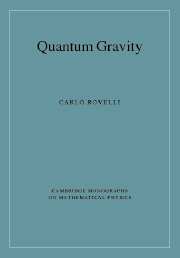9 - Quantum spacetime: spinfoams
Published online by Cambridge University Press: 06 July 2010
Summary
Classical mechanics admits two different kinds of formulations: hamiltonian and lagrangian (I never understood why). Feynman realized that so does quantum mechanics: it can be formulated canonically, with Hilbert spaces and operators, or covariantly as a sum-over-paths. The two formulations have different virtues, and calculations that are simple in one can be hard in the other. Generically, the lagrangian formalism is simpler, more transparent and intuitive and keeps symmetries and covariance manifest. The hamiltonian formalism is more general, more powerful, and, in the case of quantum theory, far more rigorous. The ideal situation, of course, is to be able to master a theory in both formalisms.
So far I have discussed the hamiltonian formulation of LQG. In this chapter I discuss the possibility of a lagrangian sum-over-paths formulation of the same theory. This formulation has been variously called sum-over-surfaces, state-sum and goes today under the name of “spinfoam formalism.” The spinfoam formalism can be viewed as a mathematically well-defined and possibly divergence-free version of Stephen Hawking's formulation of quantum gravity as a sum-over-geometries.
The spinfoam formalism is less developed than the hamiltonian version of loop theory. Also, while the general structure of the spinfoam models matches nicely with the hamiltonian loop theory, the precise relation between the two formalisms (each of which exists in several versions) is not entirely clear. But research is currently moving fast in this direction.
The aim of the spinfoam formalism is to provide an explicit tool to compute transition amplitudes in quantum gravity. These are expressed as a sum-over-paths. The “paths” summed over are “spinfoams.”
- Type
- Chapter
- Information
- Quantum Gravity , pp. 320 - 365Publisher: Cambridge University PressPrint publication year: 2004



